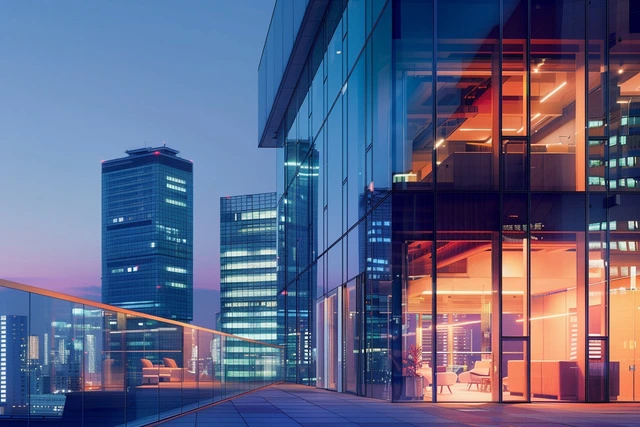Today’s commercial building lighting systems are sophisticated networks that can dramatically impact energy efficiency, occupant comfort, and even the bottom line. From LED technology to advanced control systems, the lighting revolution is transforming how we illuminate our commercial spaces.
What do we mean by commercial building lighting?
Commercial building lighting is more than just illuminating a space—it’s a crucial component of any non-residential property. From offices and retail spaces to warehouses and industrial facilities, it encompasses all the artificial light sources that keep these buildings functional, safe, and appealing.
Let’s break down the components of a typical commercial lighting system:
- Light sources: Bulbs or lamps that produce the actual light
- Fixtures: Housings that hold and direct the light
- Controls: Manages when and how lights operate
- Distribution systems: Wiring and circuitry powering it all
Concrete examples of different technologies used in real estate
Here are a few concrete examples of innovative lighting technologies in the commercial real estate industry:
- LED lighting systems: Standing at the forefront of commercial lighting, LEDs offer impressive energy efficiency, longevity, and light quality. According to ENERGY STAR, LEDs use 90% less energy than their candescent counterparts.
- Smart lighting controls: Acting as your building’s lighting butler, these systems use a mix of sensors, timers, and networked controls to ensure lights are on only when and where needed. Studies show that smart lighting solutions can reduce energy consumption in office buildings by 50%.
- Daylight harvesting systems: Working in harmony with natural light, these clever setups adjust artificial lighting based on available sunlight. For instance, a retail store could use photosensors near windows to modulate interior lighting, maintaining consistent illumination while conserving energy.
- Color-tunable lighting: Offering flexibility in ambiance creation, this technology allows adjustment of light color temperature throughout the day. High-end hotels might employ this to foster an energizing atmosphere in common areas during the daytime and a more relaxing mood in the evening.
- Human-centric lighting: Prioritizing occupant well-being, this approach mimics natural light patterns to support circadian rhythms. Healthcare facilities are adopting this technology to improve patient recovery rates and enhance staff alertness during night shifts.
How to create the optimal lighting strategy for commercial properties
A well-planned lighting strategy can enhance the appeal of your property, improve tenant satisfaction, and significantly reduce energy costs. Let’s break down the process into three key phases: evaluation, selection, and implementation.
The Evaluation: What do your commercial spaces need?
The first step in creating an optimal lighting strategy is thoroughly evaluating your property’s current lighting situation and future needs. This process involves:
- Assessing current conditions: Conduct a comprehensive audit of your existing lighting systems. At a minimum, catalog fixture types, bulb specifications, control systems, and energy consumption patterns. If you have an energy management solution, most of this data should be there.
- Identifying space-specific requirements: Different areas within a commercial property have varying lighting needs. For instance, a lobby might require bright, welcoming light, while a conference room may need adjustable lighting for presentations.
- Considering occupant feedback: Engage with tenants to understand their lighting preferences and pain points. Their input can be invaluable in creating a user-centric lighting solution.
- Analyzing energy usage: Review your property’s energy bills and lighting-related consumption to identify potential areas for improvement and energy savings.
- Evaluating natural light: Assess the availability and distribution of natural light throughout your property. This can inform decisions about daylight harvesting systems and artificial lighting placement.
The Selection: Choosing the right building lighting systems
Once you’ve completed your evaluation, it’s time to select a smart lighting system. This phase involves:
- Matching technologies to needs: Based on your evaluation, determine which lighting technologies best suit each area of your property. This might involve a mix of LEDs, smart controls, and specialized fixtures.
- Prioritizing energy efficiency: Choose systems that offer the best balance of energy efficiency and performance. Look for ENERGY STAR certified products and those with high lumens per watt ratings.
- Considering long-term costs: While upfront costs are important, also factor in long-term considerations like energy savings, maintenance requirements, and fixture lifespan.
- Ensuring compliance: Ensure your selections meet or exceed local building codes and energy regulations to future-proof your investment.
- Thinking about flexibility: Select systems that can adapt to changing needs such as color-tunable lighting or easily reprogrammable smart controls.
The Implementation: Executing your lighting plan effectively
With your strategy defined and selections made, it’s time to implement your lighting plan. This final phase includes:
- Developing a detailed plan: Create a comprehensive implementation plan that outlines the scope of work, timeline, and budget. Include any necessary electrical upgrades or structural modifications.
- Phasing the installation: For occupied buildings, consider a phased approach to minimize disruption to tenants such as working after hours or focusing on one area at a time.
- Hiring qualified professionals: Work with certified lighting designers and licensed electricians to ensure proper installation and optimal performance of your new systems.
- Training facility staff: Provide thorough training to your maintenance and facilities teams on the operation and upkeep of the new lighting systems.
- Educating tenants: Develop materials to inform tenants about the new lighting features and how to use any user-controlled elements effectively.
- Commissioning the system: Once installed, conduct a thorough commissioning process to ensure all components are working correctly and efficiently.
- Monitoring and adjusting: After implementation, continuously monitor the system’s performance and gather user feedback. Be prepared to make adjustments as needed to optimize comfort and efficiency.
Boosting sustainability and efficiency with smart lighting solutions
Modern energy management requires building optimization measures. Implementing these solutions in your property can significantly impact its value and appeal. Smart lighting solutions stand at the forefront of this movement, offering a powerful way to enhance both the environmental performance and operational efficiency of commercial buildings.
Benefits of smart commercial building lighting in CRE
Smart lighting systems offer a multitude of benefits for commercial real estate properties:
- Energy efficiency: By automatically adjusting light levels using occupancy sensors, time of day, and available natural light, these systems can cut lighting energy use by up to 90% in some cases.
- Cost savings: While the initial investment may be higher than traditional lighting, the long-term savings often result in a rapid return on investment.
- Enhanced occupant comfort: Smart lighting solutions enhance tenant comfort by supporting occupants’ circadian rhythms and boosting productivity, smart lighting systems can be programmed to mimic natural light patterns.
- Improved space utilization: Occupancy data from smart lighting systems can provide valuable insights into how different areas of a building are used, informing decisions about space allocation and design.
- Predictive maintenance: Using performance data, smart lighting systems can identify potential issues before they become problems allowing for a proactive approach to maintenance that reduces downtime and costs.
- Flexibility and control: From a centralized dashboard, property managers can adjust lighting across an entire building or campus with just a few clicks.
- Sustainability credentials: The energy savings from smart lighting can contribute significantly to green building certifications like LEED or BREEAM, enhancing the property’s appeal to environmentally conscious tenants and investors.
- Future-proofing: As a key component of smart building infrastructure, advanced lighting systems lay the groundwork for future IoT integrations and smart building features.
Implementing the latest technology using ProptechOS
ProptechOS is a cloud-based platform designed to streamline the implementation and management of proptech solutions, including advanced lighting systems. Here’s how it can facilitate the adoption of smart lighting:
- Seamless integration: ProptechOS acts as a central hub, integrating various smart building systems, including lighting, HVAC, and security. This unified approach ensures all systems work in harmony, maximizing efficiency and user experience.
- Real-time monitoring and control: The platform provides real-time data on lighting usage and performance across your property portfolio. This allows for immediate adjustments and optimizations based on actual usage patterns.
- Data-driven insights: ProptechOS’s advanced analytics capabilities can turn lighting data into actionable insights. For example, it might identify areas of over-illumination or suggest schedule changes based on occupancy patterns.
- Automated optimization: The platform can use machine learning algorithms to continuously optimize lighting schedules and settings, ensuring peak efficiency without constant manual adjustments.
Implementing smart lighting solutions through ProptechOS simplifies the adoption process and maximizes the long-term benefits. Book a demo today to see how ProptechOS can help you make the most of your smart building technology.

Dr. Erik Wallin
Chief Ecosystem Officer, and founder of ProptechOS and RealEstateCore is recognized as a leader in Building Operating Systems (BOS) and making the buildings of the world smarter. He holds an MSc and a Ph.D. in Media and Computer Science from KTH Royal Institute of Technology.
Read his full bio and information here.

